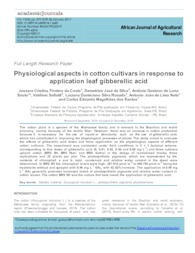Physiological aspects in cotton cultivars in response to application leaf gibberellic acid.
Physiological aspects in cotton cultivars in response to application leaf gibberellic acid.
Autoria: COSTA, J. C. F. da; SILVA, D. J. da; SOUTO, A. G. de L.; SOFIATTI, V.; ROSADO, L. D. S.; LIMA NETO, A. J. de; SANTOS, C. E. M. dos
Resumo: The cotton plant is a species of the Malvaceae family and is relevant to the Brazilian and world economy, mainly because of the textile fiber. However, there was an increase in cotton production because it is necessary for the use of inputs or stimulants, such as the use of gibberellic acid, which has contributed in improving the physiological processes of plants. The study aimed to evaluate the effects of gibberellic acid doses and foliar application on the physiological aspects of different cotton cultivars. The experiment was conducted under field conditions in 5 × 3 factorial scheme, corresponding to five doses of gibberellic acid (0, 0.01, 0.02, 0.04 and 0.06 mg L-1) and three cultivars upland cotton (BRS 8H, BRS Rubi and BRS Safira) in the design of randomized blocks, three replications and 25 plants per plot. The photosynthetic pigments, which are represented by the contents of chlorophyll a and b, total, carotenoid and relative water content in the sheet were determined. In BRS 8H the chlorophyll levels were high, 287.914 ?mol m-2 to 468.796 ?mol m-2 being the treatments without and sprayed with 0.06 mg L-1 GA3, with 62.82% increase. The application of 0.06 mg L-1 GA3 generally promotes increased levels of photosynthetic pigments and relative water content in cotton leaves. The cotton BRS 8H was the culture that best meets the application of gibberellic acid.
Ano de publicação: 2017
Tipo de publicação: Artigo de periódico
Unidade: Embrapa Algodão
Palavras-chave: Algodão, Carotenoids, Carotenóide, Chlorophyll, Clorofila, Cotton, Gibberellic acid, Gossypium hirsutum, Pigmentos fotossintéticos, Pigments, Ácido giberélico
Observações
1 - Por padrão são exibidas publicações dos últimos 20 anos. Para encontrar publicações mais antigas, configure o filtro ano de publicação, colocando o ano a partir do qual você deseja encontrar publicações. O filtro está na coluna da esquerda na busca acima.
2 - Para ler algumas publicações da Embrapa (apenas as que estão em formato ePub), é necessário ter, no celular ou computador, um desses softwares gratuitos. Sistemas Android: Google Play Livros; IOS: iBooks; Windows e Linux: software Calibre.
Acesse outras publicações
Acesse a Base de Dados da Pesquisa Agropecuária (BDPA) para consultar o acervo completo das bibliotecas da Embrapa.

